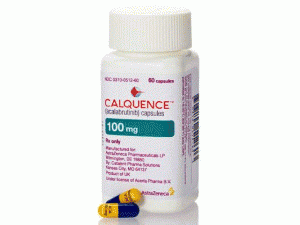阿卡替尼ACALABRUTINIB(CALQUENCE 100MG CAP)
 产地国家:美国
产地国家:美国
处方药:是
所属类别: 100毫克/胶囊 60胶囊/瓶
包装规格: 100毫克/胶囊 60胶囊/瓶
计价单位:瓶
生产厂家英文名:ASTRAZENECA PLP
原产地英文商品名:CALQUENCE 100MG CAP 60/EA
原产地英文药品名:ACALABRUTINIB
中文参考商品译名:CALQUENCE 100毫克/胶囊 60胶囊/瓶
中文参考药品译名:ACALABRUTINIB
简介
新型癌症口服药Acalabrutinib(商标名 Calquence)美国FDA加速批准用于治疗套细胞淋巴瘤FDA药物评估与研究中心的血液和肿瘤学产品办公室代理主任、肿瘤学卓越中心主任Richard Pazdur医学博士表示,MCL是一种极具侵袭性的恶性肿瘤,对于未获得缓解,或疾病复发的患者而言,Calquence提供了一种新的治疗方案,在初步研究中显示出很高的缓解率。
Calquence是一种Bruton酪氨酸激酶(BTK)抑制剂,能阻断癌细胞用于增殖和扩散所需的酶。该药曾获得FDA颁发的优先审评资格、突破性疗法认定和孤儿药资格。批准日期:2017年10月31日 公司:AstraZenecaCALQUENCE(acalabrutinib)胶囊,为口服使用美国初次批准:2017
作用机制:Acalabrutinib是BTK的一种小-分子抑制剂。Acalabrutinib和其活性代谢物,ACP-5862,来自在BTK活性部位与一个半胱氨酸残基部位共价结合,导致BTK酶活性的抑制作用。BTK为B细胞抗原受体(BCR)和细胞因子受体途径的一种信号分子。在B细胞中,BTK信号导致对B-细胞增殖,交易[trafficking],趋化作用[chemotaxis],和黏附所需途径的活化。在非临床研究中,acalabrutinib抑制BTK介导的下游信号蛋白CD86和CD69的活化和被抑制的恶性B-细胞增殖和生存。
适应证和用途:CALQUENCE是一种激酶抑制剂适用为曽接受至少一种以前治疗成年患者有套细胞淋巴瘤(MCL)患者的治疗。这个适应证是在加速批准下根据总体反应率被批准的。继续批准这个适应证可能却决于在验证性试验中的确证和临床获益的描述。
剂量和给药方法:推荐剂量是100mg口服约每12小时;与水整吞和有或无食物。忠告患者不要打碎,打开或咀嚼胶囊。用治疗中断,剂量减低,或终止处理毒性。
剂型和规格:胶囊,100mg。
禁忌证:无。
警告和注意事项:(1)出血:对出血监视和使当地处理。(2)感染:监视患者感染的体征和症状和如需要时治疗。(3)血细胞减少:在治疗期间每月监视完全血细胞计数。(4)第二个原发性额性病:在患者中曽发生其他恶性病,包括皮肤癌和其他癌症。忠告患者使用对日光防护。(5)心房颤动和扑动:监视心房颤动和心房扑动和如适当处理。
不良反应:最常见不良反应(被报告在≥ 20%的患者)为:贫血,血小板减少,头痛,中性细胞减少,腹泻,疲乏,肌肉痛,和瘀伤。
药物相互作用:(1)CYP3A抑制剂:避免与强CYP3A抑制剂共同给药。可能被建议剂量调整。(2)CYP3A诱导剂:避免与强CYP3A诱导剂共同给药。可能被推荐剂量调整。(3)胃酸减低药物:避免与质子泵抑制剂(PPIs)个体给药。与H2受体拮抗剂和抗酸剂交错给药。
特殊人群中使用:哺乳期,建议妇女不要哺乳喂养。
包装:100mg*60粒/瓶
贮存:在20°C-25°C (68°F-77°F);外出允许至15°C-30°C(59°F-86°F)[见USP控制室温]。
英文版说明书
US FDA approves AstraZenecas Calquence (acalabrutinib) for adult patients with previously-treated mantle cell lymphoma—Accelerated approval of the selective Bruton tyrosine kinase(BTK) inhibitor in MCL marks AstraZeneca’s entry into the treatment of blood cancers—80% of patients receiving Calquence achieved an overall response,with 40% achieving a complete responseCalquence® (acalabrutinib) is a bruton tyrosine kinase (BTK) inhibitor indicated for the treatment of adult patients with mantle cell lymphoma (MCL).It was developed by Acerta Pharma, AstraZeneca’s haematology research and development centre of excellence.Calquence® was granted orphan drug designation (ODD) by the US Food and Drug Administration (FDA) in September 2015. Its new drug application (NDA) was accepted for review, and priority review designation was granted by the FDA in August 2017.AstraZeneca received approval for Calquence® under the FDA’s accelerated approval pathway in October 2017.Other medications available for the treatment of MCL include Revlimid (lenalidomide) developed by Celgene Corporation and Imbruvica (ibrutinib) manufactured by Janssen Biotech and Pharmacyclics.Mantle cell lymphoma causes and symptomsMantle cell lymphoma is a type of blood cancer that occurs due to uncontrolled growth of lymphocytes. The disease occurs in forms Hodgkin lymphoma and non-Hodgkin lymphoma (NHL).MCL is a B-cell NHL that is more preva lent in men than women. Cancerous cells form tumours in the lymph nodes, which eventually enter the blood and spreads to other lymph nodes, as well as bone marrow, the digestive tract, the spleen, and the liver.Symptoms of the disease include painless swellings in the neck, armpit, and groin, loss of appetite and weight, fever, night sweats, and nausea or vomiting.An estimated 3,300 new cases of MCL are diagnosed a year in the US.Calquence’s mechanism of actionCalquence® contains a selective inhibitor BTK. It binds covalently to cysteine residue in the BTK, which is responsible for the growth and multiplication of cancerous B-cells, and inhibits its activity. The drug also activates the pathways necessary for B-cell proliferation, trafficking, chemotaxis, and adhesion.The drug is available in 100mg capsules in 60-count bottles for oral administration.Clinical trials on CalquenceFDA approval of Calquence® was based on results obtained from a Phase II clinical trial known as CE-LY-004. It was an open-label, single-arm clinical study that enrolled 124 adult patients with relapsed or refractory MCL who had received at least one prior treatment.The primary endpoint of the study was overall response rate (ORR) in subjects with previously treated MCL.The results demonstrated that 80% of patients treated with Calquence® achieved an overall response, 40% achieved a complete response, and 40% achieved a partial response based on 2014 Lugano classification and assessed by an independent review committee. The median time to best response was found to be 1.9 months.The most common adverse reactions witnessed in the clinical study in patients treated with Calquence® were anaemia, thrombocytopenia, headaches, neutropenia, diarrhoea, fatigue, myalgia, and bruising.A Phase III clinical study is currently underway to eva luate Calquence® in combination with bendamustine and rituximab (BR) versus placebo plus BR for patients with untreated MCL.
药品价格查询,专业药品查询网站,药品说明书查询,药品比价 » 阿卡替尼ACALABRUTINIB(CALQUENCE 100MG CAP)






